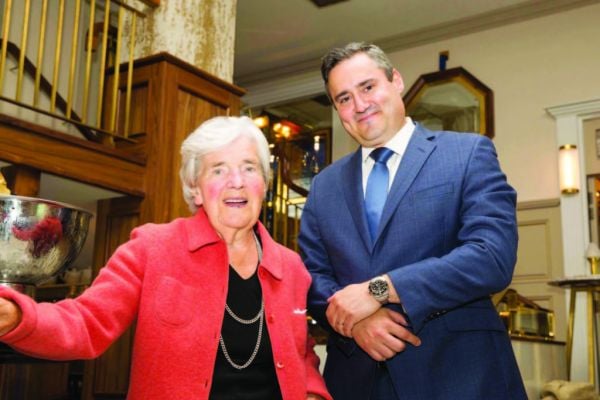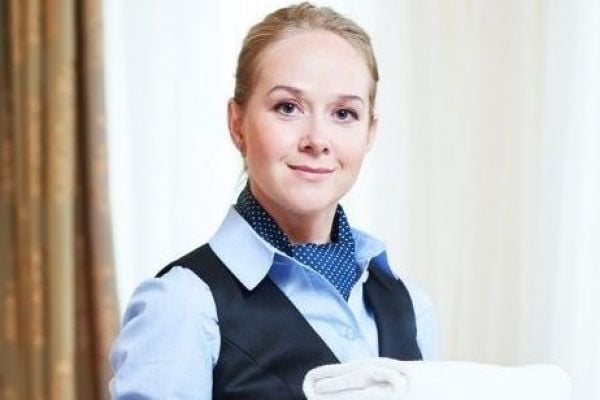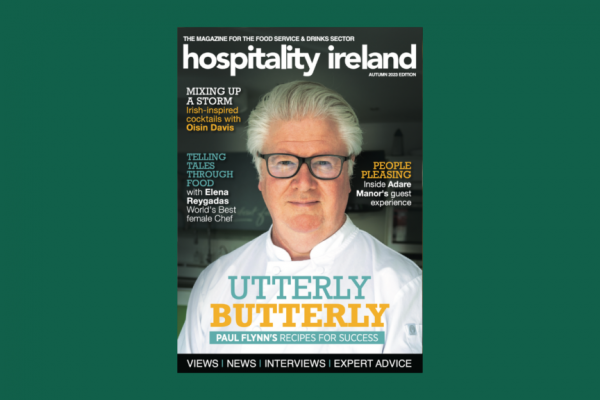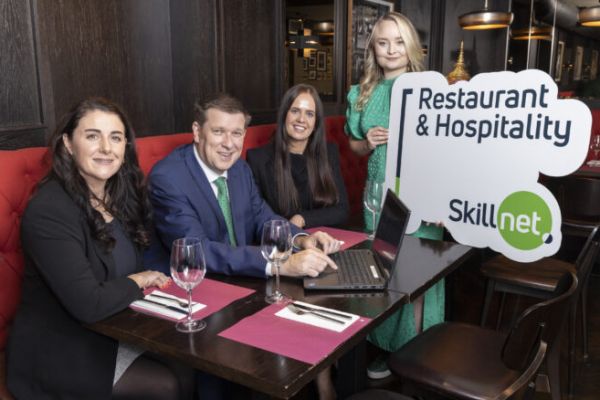In the third instalment examining how the hospitality industry is faring in regional centres around the country, Andrew Jennings travels to Cork City to speak with some of Leeside’s leading restaurateurs, hoteliers and publicans.
*****************************************************************************************************************************************
It has been said that taking a photograph, freezing a moment, reveals how rich real life truly is.
Pat O’Connell, the Cork fishmonger who gained international attention when he made Queen Elizabeth II crack up laughing during her historic visit to Ireland, is a man who knows this better than most.
When the monarch visited Cork’s English Market in 2011, she stopped at the fishmonger’s popular stall, where he whispered in her ear that he hadn’t been that nervous since his wedding day, which caused her to throw her head back in laughter.
The resulting picture became an iconic image of Cork around the globe. The moment endures and continues to be recalled daily at O’Connell’s Fishmongers, which supplies fresh seafood to some of the city’s top restaurants. Speaking about the legacy of the photograph to the Irish Independent, O’Connell remarked that tourists arrive to take photos of him at his stall pretty much “all day, every day”.
“It gets absolutely insane some days. The bigger picture is that it is bringing business to the city and tourists to the city, and the image has put Cork on the map in a lot of ways,” O’Connell revealed.
The publicity arising “has never done anything for business, but it has done an awful lot for tourism, an awful lot for Cork.”
FOOD CAPITAL
Walking down St Patrick’s Street and on to Oliver Plunkett Street, you get the impression that Cork is gradually finding its feet in the early days of post-recession Ireland.
The legacy of the dark days remains, however, with vacant pubs and restaurants noticeable, yet there’s an abundance of tourists around, although nowhere near the same degree as you now see in Dublin.
In recent positive news, Cork Airport reported a traffic increase of 19% in June, compared with the same month last year, representing the biggest monthly increase of any Irish airport for the month, making it the fastest-growing airport in the country. Year-to-date passenger numbers at the airport are also up, increasing 8.5%. Although many visitors continue to use Cork Airport as merely a landing point, as they head to West Cork, the Ring of Kerry and the rest of the Wild Atlantic Way, more and more tourists are deciding to spend a night or two in Cork City. The airport’s proximity to the city centre (6km) is an important benefit to Cork’s hospitality trade.
Speaking to tourists, it is clear that the English Market (described by British celebrity chef Rick Stein as “the best covered market in the UK and Ireland”) is at the top of most of their itineraries. The market, where traders have been selling locally produced food since the eighteenth century, remains the epicentre of Cork’s food culture, offering tourists, as well as local hospitality businesses, an array of produce found nowhere else in the country.
It is a place of which Corkonians are immensely proud, regularly the chief article of evidence that they bring out when arguing the city’s claim as the true food capital of Ireland. The rivalry for this title is undoubtedly tribal, with Dublin and Galway – and indeed Kilkenny, Waterford and Belfast – seldom given a chance to throw their hats into the ring. So, the question is: five years on from the Queen’s famous visit to the English Market, is Cork still within its rights to lay claim to Ireland’s foodie crown?
One man who knows everything there is to know about Cork’s food landscape is Denis Cotter (pictured below), chef and proprietor of Cafe Paradiso, located at Lancaster Quay, where he has worked for 23 years. Cotter is not entirely convinced. He believes that while Cork’s food culture still stands it apart from other Irish cities, restaurants might need a kick up the proverbial backside to get it back on top.
“I was in Galway not too long ago for an event, and they were very self-congratulatory about how they had stolen Cork’s food crown,” says Cotter. “To be honest, at the time, I agreed with them. I was able to take my hat off to them for doing something amazing up there.
“How do I put this nicely about Cork? I think sometimes a city can get lazy when people keep telling it how great it is, and it can stop being good. I do think we have a really great food culture, with the most amazing producers, with the best vegetable growers and cheesemakers in the country. The food public are very knowledgeable here in terms of buying local produce, however, the restaurants here don’t represent it as much as they probably should,” he adds.
Cafe Paradiso was named the best-rated fine-dining establishment in Ireland by the TripAdvisor Travelers’ Choice Awards late last year. It was the only vegetarian restaurant to win a top country prize in the 2015 worldwide awards.
“The thing about TripAdvisor is that it is based on reviews by the people who eat in restaurants, and not on what the critics are saying. That is what makes the award special,” says Cotter, who reveals that his customer base is a mix of tourists and a very strong local following.
“I think one of our strengths, even after 23 years in business, is that we are still quite a novelty to people in the area, being high-end vegetarian, and reasonably good at staying on top of our game. There are very few restaurants like us anywhere. We are really just a casual neighbourhood restaurant that works to a very high standard,” says Cotter, who adds that the restaurant seats 45 and does into the high eighties in terms of covers on a Saturday evening.
“We are not bang in the centre of town, so we get very little accidental foot traffic. People come here because they’ve already made a decision to come here. It is quite niche, but people are kind of comforted by what they read about our reputation.”
Kate Lawlor (pictured above), head chef and owner of Fenn’s Quay, not far away, on Sheares Street, agrees with Cotter that more can be done in promoting Cork as Ireland’s leading food destination. “What I dislike is that we seem to have managed to lose the title of Ireland’s food capital,” Lawlor says.
“We are one of the only cities to not have a festival in food. It would be great to see all the restaurants come together with a common aim to get people talking about the food scene in Cork.”
She believes the Cork scene is gradually returning to form, particularly in the casual-dining sector, but is concerned that restaurants continue to close in the city.
“It is a smaller city with a smaller inner-city population, so the more restaurants that open, the more competition there is for custom,” says Lawlor. “What is positive is that independent restaurants are performing well, despite chains like Starbucks and Nando’s opening in the city.”
Lawlor concedes that restaurants in Cork struggled massively during the worst of the recession, as fewer and fewer people ate out of home, and the ones who did spent considerably less. “It was very tough for our own restaurant,” she says.
“We had business partners who left the business, but we were very lucky that the landlord dropped the rent to a more realistic level, or we would have been gone. Turnover dropped, and it got to a point of not knowing would we make it to the end of the month, once loans, wages and bills were paid. We had to go through a major restructuring of the business. Even now, we’re still running things on a tight margin to try make it work.”
Over the years, Lawlor’s been lucky to get great advice and support from some of the longer-established restaurants in the city, such as Isaacs, Jacques and the Cornstore, while collaborating with exciting newcomers like Miyazaki, Iyer’s, and the Rocket Man.
“I enjoy meeting up with other chefs. I meet Pamela Kelly [Market Lane, Cork], Leona Robinson [Nine Market Street, Kinsale], Kevin Aherne [Sage, Midleton] and Bryan McCarthy [Greenes, Cork]. I do feel it’s important to know other chefs, as we offer each other support and advice. While we all compete for business, we do need to work together to get Cork back on the food map.”
Lawlor says that while Cork restaurants are getting busier, “The market is still in a bit of a bubble, where one pin prick, and it could burst.
“Although the tourist season is going well, the spend seems lower, with some opting to share a starter, main or dessert, or just have a main. They are very much on a budget,” she says, adding that locals make of 90% of her daytime custom and around 60% in the evening. In terms of dinner/supper covers, Fenn’s Quay’s 58-seater restaurant, which employs 13 staff (three full time and ten part time), does 20-30 from Monday to Wednesday, around 40 on Thursday, 60 on Friday, and 70-90 on Saturday.
Echoing Cotter’s comments about Cork restaurants needing to up the ante in terms of promoting the city’s food offering, Lawlor believes that restaurants in the city need to find a common ground and work together.
“Perhaps we need to get a food festival together and get things moving,” she says. “Jack Crotty of the Rocket Man is responsible for the long-table supper and a few other events in the city that are food related. It’s great to have someone of his talents trying to get people talking about food in Cork. “Bryan McCarthy of Greenes is very much raising the bar in relation to fine dining in Cork – perhaps a Michelin star is what he is aiming for. We have some cracking new eateries here, of all varying styles, with the likes of Elbow Lane springing to mind.
“What I love [about Cork dining] is the people in it. The owners here have a great sense of community. Whether it be at L’Atitude 51, Idaho Cafe, or the team at Cafe Paradiso, everyone wants to see others do well across the board.”
BAR TALK
Behind The Bar Costigan’s, located on Washington Street West, describes itself as ‘a lively bar with a traditional and cosy feel’.
Bar manager Colm Lynch, who took up the lease alongside business partner Eugene McCarthy last October, tells me that the premises, which plays live music four nights a week, is a dying breed among public houses. Colm says that he’s been happy enough with business so far this summer, thanking footfall from tourists as a massive part of the business, particulary with local custom quieter in July and August, as Corkonians leave the city on holidays.
“We’ll wait and see what the rest of summer brings, but it’s been good so far,” says Lynch, adding that most pubs in Cork get the majority of their revenue from Friday and Saturday nights. “In saying that, you can have a savage Thursday night, or even a random Monday night, when we’re out the door,” he adds, “like we had a few weeks back, when we only had two barmen on, but we had music going and the place was jam-packed, so I had to help the lads out behind the bar.”
Lynch says that he dedicates time to lifting his pub’s rating on TripAdvisor, with his hard work seeing the pub move from 67th up to seventh on the list of Cork pubs since late last year. “It’s all about grabbing tourists’ attention,” he says. “They all look at it [TripAdvisor], so we knew we needed to improve our ranking. We respond to all messages on it, be it good or bad. If we do get a bad one, it’s a learning experience.”
Costigan’s keeps it simple regarding food. At the moment, the pub is keeping it along the lines of a pint-and-toasted-special offering, but Lynch says that it is something they will look to improve on in the future.
“As a pub, we believe in keeping it simple. People, whether locals or tourists, are made to feel welcome as soon as they walk through the door. What I find in a lot of pubs around Ireland is that when you ask the barman for something, well, it’s like getting one of his kidneys or something. One TripAdvisor message that was left for us recently read, ‘Great pub. Made to feel like a regular.’ For us, that’s job done.”
LODGINGS
The Irish Examiner reported in May that Ireland’s largest hotel operator, Dalata, will have spent up to €90 million on Cork City hotels by next year, spanning purchases, upgrades and completion of its Beasley Street site, off Cork’s South Mall, and Parnell Place, where a €10.2-million purchase from Nama has finally been completed.
According to Dermot Crowley, Dalata’s deputy CEO of business development and finance, this latest purchase, with provision for at least 120 bedrooms, will give it control of approximately 20% of Greater Cork’s hotel stock, over 530 bedrooms. For some of Cork’s existing hoteliers, this represents competition on the horizon, but they also welcome it in terms of attracting more visitors to a city that needs more beds. “
The hotel is very busy currently. We have had a strong summer so far,” says Frits Potgieter (pictured below with Myrtle Allen), manager at the Imperial Hotel.
“The last 12 months have certainly been more positive in terms of growth. There is a definite uplift in tourist numbers, which is positively affecting hotels across Ireland, including Cork.”
Potgieter reveals that in terms of revenue, food and beverage generates around 47% of the total at the Imperial, compared to 43% in rooms, adding that the hotel market in Cork has experienced an uplift post-recession, but not to the same extent as Dublin. “The market here is recovering, but at a slower, more gradual pace,” he says.
“We would compare ourselves with Galway and Waterford from a leisure-business-segment perspective and Dublin from a corporate-business perspective, as Cork is a key business city in Ireland, with a very strong international corporate element.” In terms of occupancy this summer, the Imperial is currently running at around 90%, and for the year, approximately 75%. “Occupancy levels have increased, but, again, not exponentially. It seems to be more gradual for Cork,” says Potgieter.
Some 57% of the Imperial’s guests are domestic. Around 18% are from the US, which, Potgieter says, “is brilliant, and then the UK would be our third-largest segment, at 16%. Around a third of our business is from repeat customers.”
Potgieter adds that the Imperial is always aiming to deliver good margins, but also believes that “to create and deliver a brilliant guest experience, we’ve had to invest, not only in the product, but also in our people, and this means increased payroll, our biggest cost, although we’d like to think of this as a human-capital investment, not just a cost”.
Ruairi O’Connor, manager at the River Lee Hotel, agrees that 2016 has been an excellent year, and the outlook is positive.
“We have had consistent growth since the recession hit,” O’Connor says. “This year has been extremely positive. We definitely have some catching up to do with Dublin, but we’ve seen good, steady growth in rate and demand.”
O’Connor says that food makes up 25% of the River Lee’s revenue per year. “Again, over the past 12 months, our investment and development of offerings such The Juicery (exclusive to The Doyle Collection), brunch, and afternoon tea on our terrace have had a major positive impact on trading,” he says, adding that the hotel, which has 115 full-time employees, gets quite a lot of repeat business.
“So far this year, the ratio has been Ireland 40%, the US 22%, and Great Britain 18%,” says O’Connor.
Meanwhile, at the Blue Book-listed Hayfield Manor, accommodation alone has seen a 14% increase year on year, and a 10% increase on business in general.
“You might walk around the lobby and hear American accents,” says Ettienne Van Vrede, who is married to Annemarie Scally, daughter of the Scally family, which owns Hayfield, and joint manager with Annemarie. “We’re quite lucky in the sense that we have a nice mix of clients, with good corporate business in the first three months of the year, then going into the second quarter, the leisure market kicks in.
“So, if we look at the second quarter, 46% of our clients would be leisure/foreign, which means a lot of Americans staying with us. At the moment, 80% is leisure, and 40% of that is foreign. We do see a bit of the domestic market over the second quarter, then weekends are strong for Irish visitors. Van Vrede says that Hayfield has 119 full-time staff, while food and beverage accounts for 45% of revenue versus 55% for accommodation. “We do rely heavily on foreign leisure travellers,” he says. “For example, of our second quarter this year, 46% is American.
"We have a very high percentage of repeat visitors. It shows we’re doing something right. We have a niche market in Cork. There’s nothing else like that."












